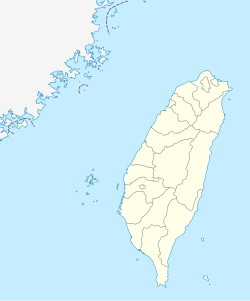Nangan, Lienchiang
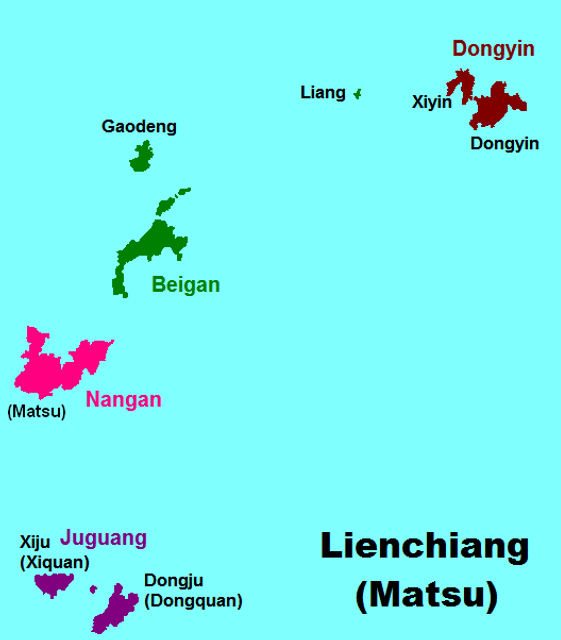
Nangan, Lienchiang

Nangan 南竿鄉 Nankan | |||||||||||||||||||||||
|---|---|---|---|---|---|---|---|---|---|---|---|---|---|---|---|---|---|---|---|---|---|---|---|
Rural Township | |||||||||||||||||||||||
| Nangan Township | |||||||||||||||||||||||
 | |||||||||||||||||||||||
| Coordinates:26°09′N 119°56′E [21] | |||||||||||||||||||||||
| Country | Republic of China (Taiwan) | ||||||||||||||||||||||
| County | Lienchiang County | ||||||||||||||||||||||
| Rural villages | 9 | ||||||||||||||||||||||
| Government | |||||||||||||||||||||||
| • Mayor | Chen Chen-ko (陳振國) (KMT) | ||||||||||||||||||||||
| Area | |||||||||||||||||||||||
| • Total | 10.64 km2(4.11 sq mi) | ||||||||||||||||||||||
| Population (June 2016)[2] | |||||||||||||||||||||||
| • Total | 7,442 | ||||||||||||||||||||||
| • Density | 700/km2(1,800/sq mi) | ||||||||||||||||||||||
| Postal code | 209 | ||||||||||||||||||||||
| Area code(s) | (0)836 | ||||||||||||||||||||||
| Website | http://www.nankan.gov.tw/ [22] | ||||||||||||||||||||||
| Nangan, Lienchiang | |||||||||||||||||||||||
| Traditional Chinese | 南竿鄉 | ||||||||||||||||||||||
| |||||||||||||||||||||||
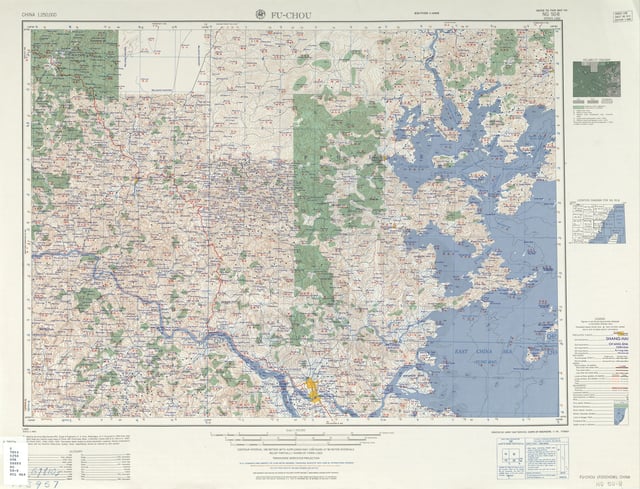
Nangan Island in the East China Sea (labelled as MA-TSU (ISLAND) 馬祖) (1954)
Nangan Township (Chinese: 南竿鄉) is a rural township in the Matsu Islands and the county seat of Lienchiang County, Taiwan.[3]
There is an airport in Nangan. The highest point is Yuntai Mountain, at 248 m (814 ft) above sea level.
Nangan 南竿鄉 Nankan | |||||||||||||||||||||||
|---|---|---|---|---|---|---|---|---|---|---|---|---|---|---|---|---|---|---|---|---|---|---|---|
Rural Township | |||||||||||||||||||||||
| Nangan Township | |||||||||||||||||||||||
 | |||||||||||||||||||||||
| Coordinates:26°09′N 119°56′E [21] | |||||||||||||||||||||||
| Country | Republic of China (Taiwan) | ||||||||||||||||||||||
| County | Lienchiang County | ||||||||||||||||||||||
| Rural villages | 9 | ||||||||||||||||||||||
| Government | |||||||||||||||||||||||
| • Mayor | Chen Chen-ko (陳振國) (KMT) | ||||||||||||||||||||||
| Area | |||||||||||||||||||||||
| • Total | 10.64 km2(4.11 sq mi) | ||||||||||||||||||||||
| Population (June 2016)[2] | |||||||||||||||||||||||
| • Total | 7,442 | ||||||||||||||||||||||
| • Density | 700/km2(1,800/sq mi) | ||||||||||||||||||||||
| Postal code | 209 | ||||||||||||||||||||||
| Area code(s) | (0)836 | ||||||||||||||||||||||
| Website | http://www.nankan.gov.tw/ [22] | ||||||||||||||||||||||
| Nangan, Lienchiang | |||||||||||||||||||||||
| Traditional Chinese | 南竿鄉 | ||||||||||||||||||||||
| |||||||||||||||||||||||
Name
Nangan Township is named for Nangan Island (Nankan Island[4]), the main island in the township. Nangan was also known Nangantang (南竿塘[5]; Nàng-găng-dòng). Because Lin Moniang's (who later became the goddess Matsu) corpse was washed ashore here, Nangan was also known as Matsu Island / Ma-tsu Island / Matsu Shan / Matsu-Shan[6] (Matsoo[7]/ Matsoo shan[8]) (馬祖島[5]; Mā-cū-dō̤). In Song and Ming records, Nangan Island (Matsu Island) was called Shanggantang/Shanggantangshan (上竿塘/上干塘/上竿塘山) as opposed to Beigan Island, which was called Xiagantang/Xiagantangshan (下竿塘/下干塘/下竿塘山).[9][10]
History
In 1935, a baojia was created including Nangan Island.[11]
In 1949, ROC forces were stationed on Nangan Island.[11]
At 3 AM on January 9, 1966, three seamen from the PRC defected to the ROC at Nangan (Nankan) Island. They were ambushed and killed in transit to Taipei.[12]
In 2000, as part of the Three Links, transportation betwen Nangan Island's Fuao and Mawei District in Fuzhou was established.[11]
In 2003, Nangan Airport was opened.[11]
Geography

Huangguan Yu (黃官嶼)
The island of Nangan is not only the largest island of its township, but also the largest island of Matsu. Nangan Township is also the largest township in Lienchiang County, with a population of about 4,000. The highest point of the island is the Yuntai Mountain peak at 250m. Nangan's climate is classified as subtropical, with distinct seasons. The average year-round temperature is 20C, with July and August reaching 34C and January temperatures as low as 1.8C. There is an intense fog period during March and April which often affects the scheduled flights at Nangan Airport.
Other islets in Nangan Township include Huangguan Yu (黃官嶼), Xie Jiao (鞋礁), Beiquan Jiao (北泉礁), and Liuquan Jiao (劉泉礁).
Politics and government
Administrative divisions
There are 10 villages located on Nangan. At the eastern end of the island is Jieshou (介壽村), the seat of the county government and the largest village. Following the coastal road west from Jieshou, there are Fuxing (復興村), Fuao (福澳村), Qingshui (清水村), Zhuluo (珠螺村) and Mazu (馬祖村). Following the mountain road west, there are Meishi (梅石村), Renai (仁愛村) and Jinsha (津沙聚落), before once again reaching Mazu. Located to the north of Mazu is Siwei (四維村). In addition to these, there are two smaller villages or clusters of homes. These are Furen (夫人村) and Ketiao (科蹄澳), they are located near Siwei.
Many villages on Nangan have two names. In some cases, this was the result of politics, as one is the traditional name and the second has a political connotation. These instances are paired as follows with the traditional name first: Shanlong (山隴): Jieshou (介壽), Niujiao (牛角(聚落)): Fuxing (復興), Tieban (鐵板): Renai (仁愛), and Fuao (福澳): Jingze (經澤). These names are often used interchangeably by residents, except for Jingze. Residents objected to this latter name, and so it never came into popular use. The reference to Shanlong is also important as there is a neighborhood there called Zhonglong (中隴). Mazu is also referred to as Magang (馬港) and Siwei as Xiwei (西尾). As for Mazu and Magang, Magang is the preferred name. This could be in order to distinguish the village and its harbor from Mazu (媽祖), the goddess, and Mazu (馬祖) the island chain. Xiwei was derived from the local Fuzhou dialect's pronunciation of Siwei.
Jieshou (Chinese: 介壽村; Hanyu Pinyin: Jièshòu Cūn; Tongyong Pinyin: Jièshòu Cun) literally, "Longevity for Chiang Kai-shek "
Jinsha (Chinese: 津沙村; Hanyu Pinyin: Jīnshā Cūn; Tongyong Pinyin: Jinsha Cun) "Sand of Seaport"
Cingshuei / Qingshui (Chinese: 清水村; Hanyu Pinyin: Qīngshuǐ Cūn; Tongyong Pinyin: Cingshuěi Cun) "Pure Water"
Jhuluo (Chinese: 珠螺村; Hanyu Pinyin: Zhūluó Cūn; Tongyong Pinyin: Jhuluó Cun) "Pearl and Snail"
Fusing / Fuxing (Chinese: 復興村; Hanyu Pinyin: Fùxīng Cūn; Tongyong Pinyin: Fùsing Cun) "Revive Prosperity"
Fuwo (Chinese: 福沃村; Hanyu Pinyin: Fúwò Cūn; Tongyong Pinyin: Fúwò Cun) "Auspicious Fertility": Jingze Village (經澤)
Ren-ai (Chinese: 仁愛村; Hanyu Pinyin: Rén'ài Cūn; Tongyong Pinyin: Rén-ài Cun) "Humanity and Love": Tieban (鐵板 "Iron Plate") until 1955 .
Matsu (Chinese: 馬祖村; Hanyu Pinyin: Mǎzǔ Cūn; Tongyong Pinyin: Mǎzǔ Cun; Wade–Giles: Ma3-tsu3 Ts'un1) "Matsu"
Sihwei / Siwei (Chinese: 四維村; Hanyu Pinyin: Sìwéi Cūn; Tongyong Pinyin: Sìhwéi Cun) "Four Virtues"
Government institutions
Lienchiang County Government
Lienchiang County Council
Mayors
Appointed mayors[15]
Li Chun-Hua (李春華)
Nieh Ko-Tung (聶國棟) (1959-1960)
Pan Fu (潘輔) (1960-1962), later mayor of Beigan
Yu Te-Chu (尤德渠) (1962), also mayor of Beigan
Hsueh Chih-Lien (薛繼廉) (1962-1965), later mayor of Juguang
Pan Fu (潘輔) (1965-1973)
Chen I-Peng (陳一鵬) (1973-1978), former mayor of Beigan and Juguang
Elected mayors
Yeh Chin-Fu (葉金福) (1978-1982)
Chang Hsiang-Shou (張祥壽) (1982-1986)
Chiu Ying-Piao (邱英鑣) (1986-1990)
Chen Shu-Li (陳書禮) (1990-1998)
Chen Hsiu-Hua (陳秀華) (1998-2002)
Lin Shu-Ching (林樹清) (2002-2006)
Chu Hsiu-Ping (朱秀平) (2006-2014)
Chen Chen-Ko (陳振國) (2014-present) (KMT)[16], in 2018 received nearly four-thousand votes[17]
Tourism
The Palace of Heavenly Empress (天后宮) in Matsu Village contains the coffin of Lin Moniang. The temple also contains statues of the guards, Thousand-li Eye (千里眼) and Wind-following Ear (順風耳). There is an annual celebration on March 3.
Matsu Distillery (馬祖酒廠) on Wujiao Hill (午角嶺) in Fusing Village produces daqu wine (大麴酒) and sorghum wine (高梁酒).
Shengli Water Reservoir (勝利水庫 "Victory") and a museum are located in Cingshuei Village. The museum contains four cannons from Jyuguang which were used to guide boats. Another museum is the Matsu Folk Culture Museum and Ching-Kuo Memorial Hall.
There are two abandoned military tunnels on the island: Tunnel 88 and Beihai Tunnel. Former military stronghold is Dahan Stronghold.
Nature in the township is Shengtian Park.
Infrastructure
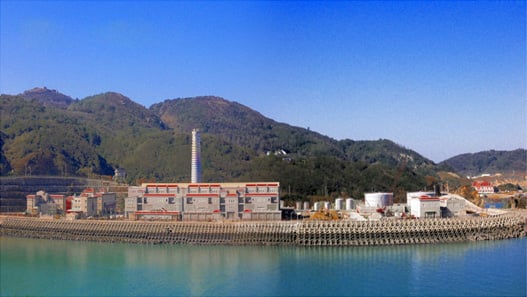
Zhushan Power Plant
The electricity for the township is supplied by Zhushan Power Plant.
Transportation
Air
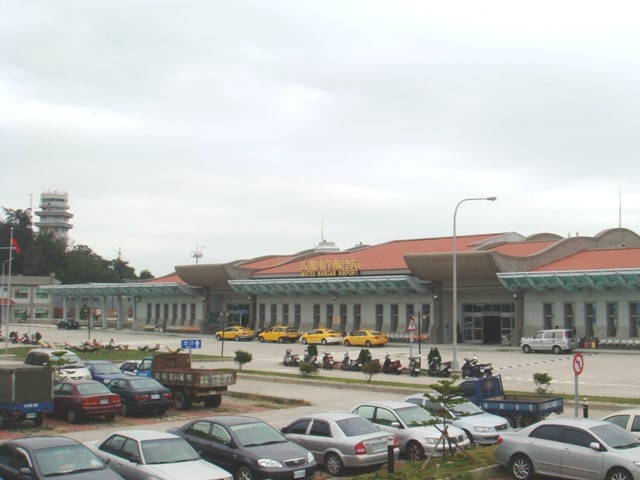
Matsu Nangan Airport
Uni Air is the only airline serving the island, with eight flights a day to Nangan Airport and three flights a day to Beigan Airport. All of the above flights arrive at Songshan Airport in Taipei with the exception of one flight at Taichung Airport in Taichung.
Water
Commercial boat rides are provided hourly every day from 7am to 5pm. The rides take approximately 10 minutes to Beigan.
Commercial boat rides to Juguang Island takes approximately an hour with three rides a day.
There are ferryboat scheduled on a weekly basis between Keelung Port and Nangan's Fuao Harbor.
Road
The township has bus services connecting its villages, which consists of coastal line and mountain line.[18]
Notable natives
Yang Sui-sheng, Magistrate of Lienchiang County (2009–2014)
See also
List of islands of Taiwan
List of islands in the East China Sea
